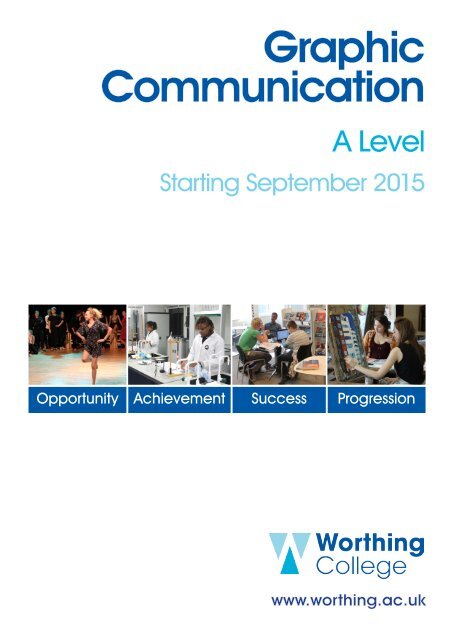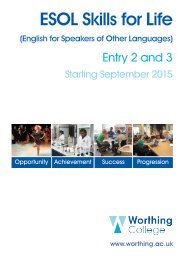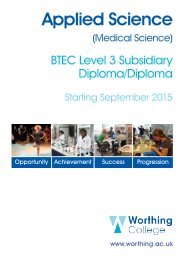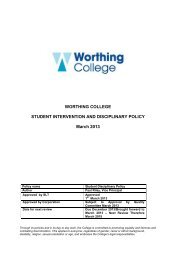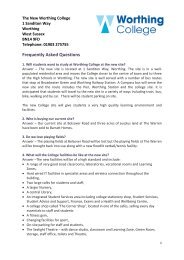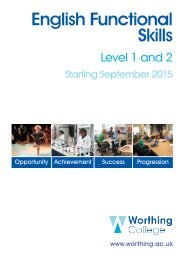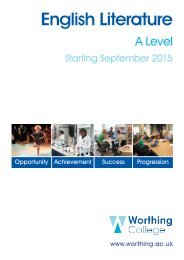Graphic Communication AS/A Level - Worthing College
Graphic Communication AS/A Level - Worthing College
Graphic Communication AS/A Level - Worthing College
You also want an ePaper? Increase the reach of your titles
YUMPU automatically turns print PDFs into web optimized ePapers that Google loves.
<strong>Graphic</strong><br />
<strong>Communication</strong><br />
A <strong>Level</strong><br />
Starting September 2015<br />
Opportunity Achievement Success Progression<br />
www.worthing.ac.uk
When do I start studying for<br />
this qualification?<br />
September 2014.<br />
For how long will I study?<br />
For two years.<br />
What is this course about?<br />
<strong>Graphic</strong> communication conveys<br />
information and ideas through visual<br />
means. The critical element for a<br />
graphic designer is the effective<br />
communication of a message or idea<br />
through the organisation of images<br />
and words. <strong>Graphic</strong> designers need to<br />
understand user and audience needs<br />
and how these groups respond to<br />
various forms of visual communication.<br />
What topics will I study?<br />
For the purposes of this qualification,<br />
graphic communication is sub-divided<br />
into the following four disciplines:<br />
• Advertising<br />
• Illustration<br />
• Branding<br />
• Information design.<br />
Students will be required to work<br />
in one or more of the disciplines to<br />
communicate their ideas.<br />
Drawing and other materials<br />
processes<br />
Drawing in the context of graphic<br />
communication forms an essential<br />
part of the development process from<br />
initial idea to finished product; from<br />
rough sketches to diagrams setting<br />
out designs, including digital drawings.<br />
Students should use a variety of<br />
tools and materials, as appropriate,<br />
for recording their surroundings and<br />
source materials.<br />
Contextual understanding and<br />
professional practice<br />
Students should incorporate contextual<br />
investigation and translation as<br />
inspirational starting points for their<br />
development work. They will consider the<br />
work of others and use understanding<br />
gained to inform the progression of their<br />
own personal creativity.<br />
When undertaking work in graphic<br />
communication, students will be<br />
required to engage with:<br />
• A range of materials and tools for<br />
graphic communication, including,<br />
where appropriate, digital media.<br />
• Ways in which information and ideas<br />
can be effectively communicated<br />
through an organisation of images<br />
and words.<br />
• How audiences may respond to the<br />
use of words, images and formal<br />
elements, with particular reference<br />
to colour, shape and composition.<br />
• The basic typographical and layout<br />
requirements for digital and printbased<br />
products.<br />
• Historical and contemporary themes<br />
and sources within the context of<br />
the chosen discipline.<br />
How will my work be<br />
assessed?<br />
There are two parts to the A <strong>Level</strong>.<br />
Component 1 Personal Investigation<br />
This component incorporates three<br />
major elements:<br />
• Supporting studies,<br />
• Practical work<br />
• Personal study of a minimum 1000<br />
words of continuous prose.<br />
Component 2 Externally Set<br />
Assignment<br />
The exam board set theme is<br />
distributed in February, you will have 8<br />
weeks to investigate, develop and plan<br />
your response to the theme. You then<br />
have 15 hours to produce a personal<br />
outcome.
Your work will be assessed by your<br />
teacher throughout the year with written<br />
and verbal feedback given. At the<br />
end of the course both components<br />
are internally marked and externally<br />
moderated.<br />
All work is assessed with reference to<br />
the four exam board set criteria:<br />
• Develop ideas<br />
• Explore media<br />
• Research record analyse review<br />
• Present outcomes.<br />
What skills will I need to<br />
develop during the course to<br />
succeed?<br />
You will need to develop good<br />
practical skills in terms of gathering<br />
visual sources and using graphic<br />
communication techniques and<br />
processes.<br />
You will need to learn to be enquiring<br />
and analytical when looking at the work<br />
of other designers and illustrators, and<br />
making connections to your own work.<br />
The course will introduce new<br />
techniques and processes assuming<br />
you have not used them before. If you<br />
have previous knowledge you will be<br />
able to build on it, extending your skills<br />
and ideas.<br />
Are there any specific entry<br />
requirements?<br />
You will need a minimum of five GCSEs<br />
at A* - C grade, including Art and<br />
Design or <strong>Graphic</strong>s. Students who do<br />
not have Art and Design or <strong>Graphic</strong>s<br />
GCSE will be invited to college to do<br />
a short practical task before being<br />
accepted on the course.<br />
What are the lessons like?<br />
A range of teaching and learning<br />
styles is used during the course.<br />
Group briefings, slide shows, practical<br />
demonstrations, research tasks,<br />
discussions, group and individual<br />
critiques.<br />
For much of the course you are working<br />
on individual, practical, Mac based ICT<br />
or research based tasks. 1:1 support is<br />
available to all students.<br />
What do students say about<br />
this course?<br />
“The course is very different from<br />
GCSE but very challenging and<br />
satisfying.”<br />
“I am surprised at the way my work has<br />
changed and intend to study <strong>Graphic</strong><br />
Design at a higher level when I finish<br />
my A <strong>Level</strong>s.”<br />
“We are frequently given individual<br />
advice on the development of practical<br />
ideas and introduced to inspiring<br />
sources.”<br />
“Doing homework when it is set has<br />
helped me to keep up to date on the<br />
course.”<br />
What have I got to do in order<br />
to do well?<br />
• Be creative and inventive with a<br />
variety of materials and techniques.<br />
• Manage time efficiently to complete<br />
all practical and research tasks.<br />
• Learn by exploring the work of other<br />
designers and illustrators.<br />
• Be prepared and equipped for all<br />
lessons.<br />
• Record feedback and act upon it to<br />
move on creatively.<br />
• Consider ideas in other designers’<br />
work and understand how they got<br />
their ideas.<br />
• Record Primary Research from Life.<br />
• Keep up to date with design<br />
magazines such as ‘Aesthetica’ and<br />
‘EYE’.<br />
(continued overleaf)
Is there a similar qualification<br />
to this one? If so how do I<br />
choose between them?<br />
There are four Visual Arts subjects:<br />
Fine Art, <strong>Graphic</strong> <strong>Communication</strong>,<br />
Textiles and Photography. Each follows<br />
the same specification and requires the<br />
development of a creative approach<br />
but a range of different techniques<br />
are learnt in each subject. There are<br />
different entry requirements.<br />
Are there any other<br />
qualifications which combine<br />
particularly well with this one?<br />
Some students choose to study several<br />
Visual Arts subjects, others choose<br />
<strong>Graphic</strong> <strong>Communication</strong> to compliment<br />
a diverse range of other subjects.<br />
What do people do with A level<br />
<strong>Graphic</strong> <strong>Communication</strong>?<br />
Many students go on to an Art<br />
Foundation course. This is a general<br />
diagnostic year that allows students<br />
to try all Art and Design specialisms<br />
before going on to an higher education<br />
course. Some universities will accept<br />
students onto a Design degree with A<br />
levels and a portfolio, but many prefer<br />
students to complete the Foundation<br />
year.<br />
Career opportunities exist in graphic<br />
design, illustration, publishing, digital<br />
marketing, Branding, creative direction,<br />
styling, company identity, interior<br />
design, web design, advertising,<br />
animation, and teaching.<br />
Students can go on to work for<br />
companies or as freelance designers.<br />
<strong>Graphic</strong> <strong>Communication</strong> A <strong>Level</strong> can<br />
also accompany other subjects and<br />
contribute a qualification to unrelated<br />
higher education applications and<br />
career paths.<br />
Correct at issue date. Please see www.worthing.ac.uk for updates.<br />
Apply now on-line at www.worthing.ac.uk<br />
T: 01903 275755<br />
E: info@worthing.ac.uk<br />
Issue 09.2014


